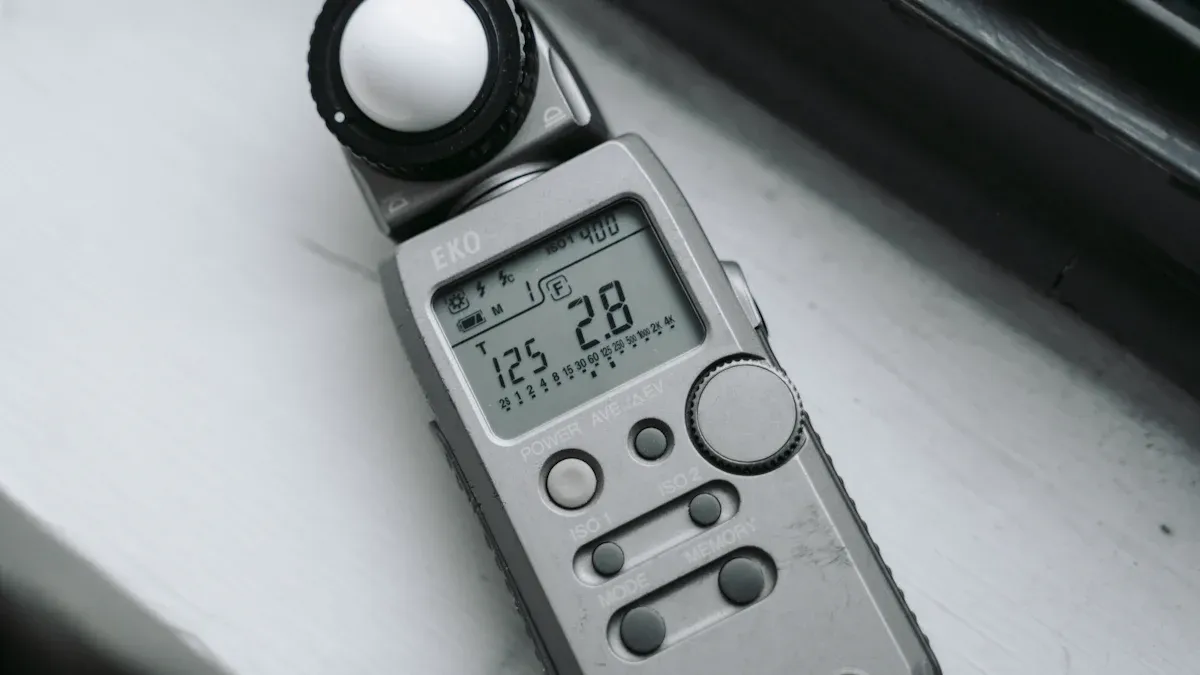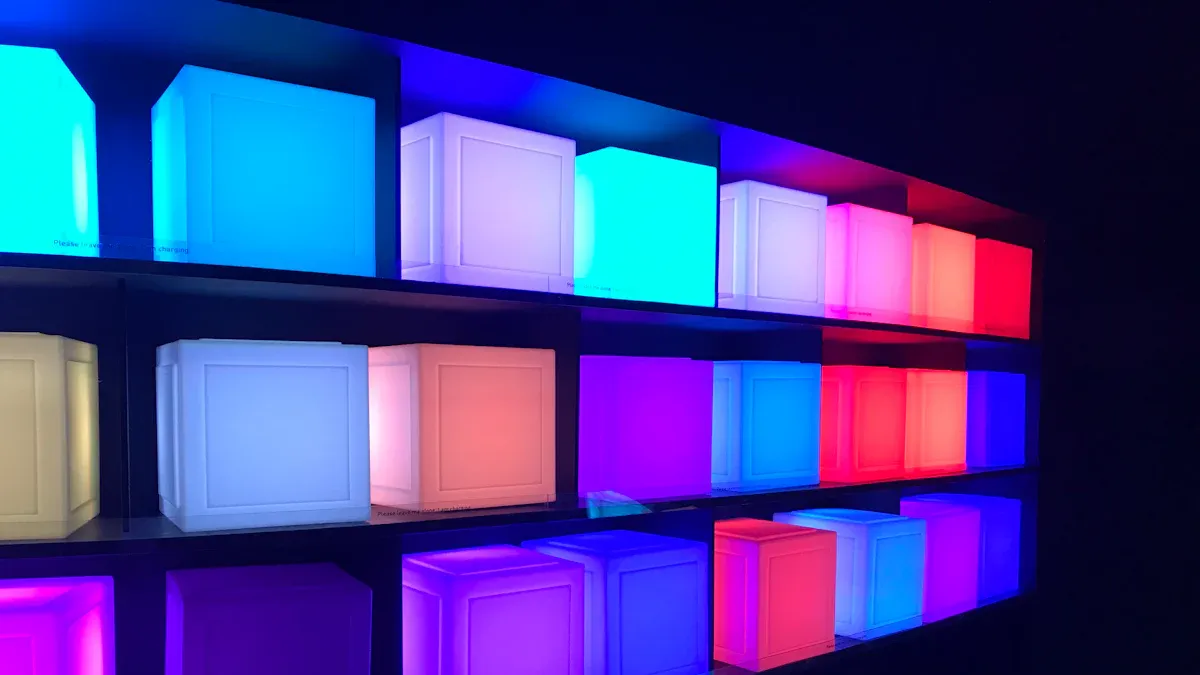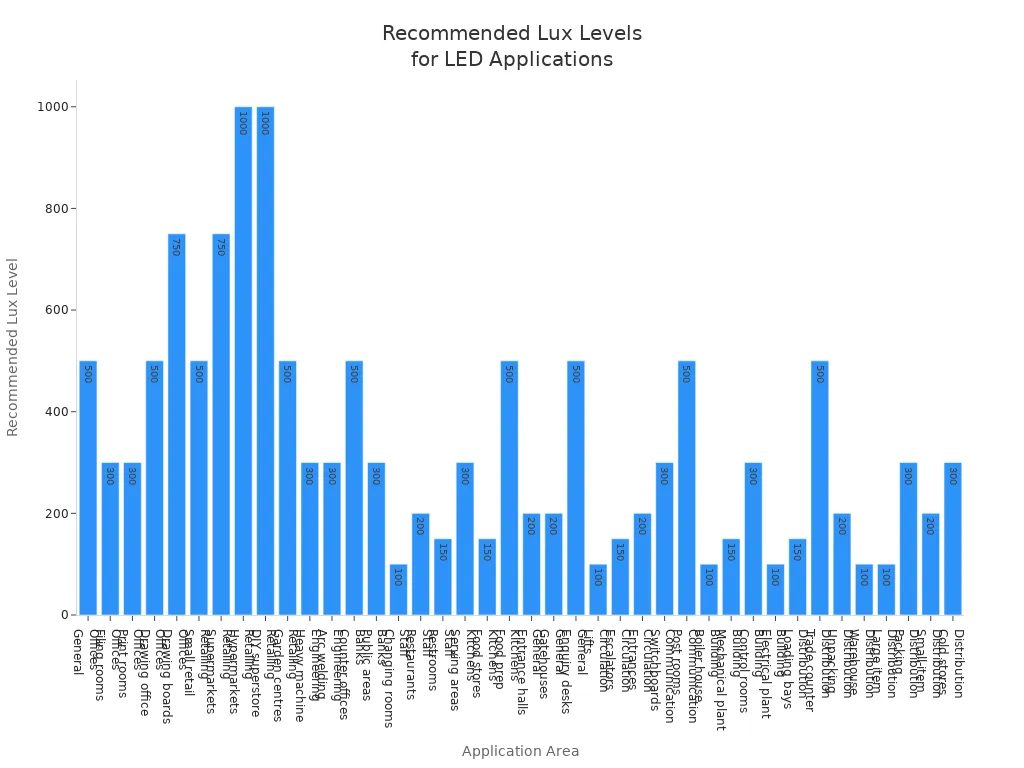Lux vs Lumens: The Complete Guide to Understanding Light Measurement Units for LED Light Boxes

You might feel puzzled when you shop for LED light boxes and see words like lux and lumens. Knowing these light measurement units helps you pick the best led lighting for your space. When you understand the difference, you can choose the right brightness and comfort for your room or task.
Lumens show how much total light the led gives off.
Lux tells you how that light spreads across an area.
The right lux level makes your work easier and safer.
Good lighting design looks at both lumens and lux for comfort.
Key Takeaways
Lumens show how much light comes from a source. You can use lumens to see which LED light is brighter.
Lux tells you how much light hits a certain spot. Look at lux to make sure your workspace has enough light for work.
You should think about both lux and lumens when picking LED lights. This helps you make spaces that feel good and work well.
Different places need different lux amounts. Kitchens need 500-700 lux. Bedrooms need 100-150 lux.
Knowing how lux and lumens work together helps you pick better lighting. It also keeps you safe and helps you get more done.
Lux vs Lumens Difference
Key Distinctions
When you compare lux vs lumens, you see two important ways to measure light. You use lumens to find out how much total light comes from a light source. You use lux to check how much light reaches a surface. These units help you understand how bright a space will feel and how well you can see your work.
Lux measures the intensity of light on a specific surface. One lux equals one lumen per square meter. You use lux to judge how well-lit a desk, floor, or wall will be.
Lumens show the total amount of visible light a light source gives off. You use lumens to compare the brightness of different bulbs or fixtures.
Lux and lumens work together. If you have a 1000 lumen light source shining on one square meter, you get 1000 lux. If you spread that same light over ten square meters, you only get 100 lux on each square meter.
You cannot convert between the two readings without knowing the area the light covers. The size of the space changes how lux and lumens relate.
Lighting professionals use lumens to plan the total output for a room. They use lux to make sure each area gets enough light for safety and comfort.
Lux is critical in places like offices, warehouses, and labs. You need the right illuminance for tasks and safety. Lumens help you pick the right light source for your needs.
Tip: Always check both lux and lumens when you choose LED lighting. This helps you match the light source to your space and tasks.
Here is a quick comparison to help you understand lumens vs lux:
Metric | Definition | Practical Application |
|---|---|---|
Lumens | Total light output from a source | Comparing overall brightness of light sources |
Lux | Light intensity on a surface (lumen/m²) | Assessing suitability for specific tasks |
Example | 6000 lumens can provide 600 lux at 2m distance | Ensuring proper illumination on work surfaces |
Relevance for LED Lighting
You need to know the difference between lux and lumens when you choose LED lighting. Lumens tell you how much light a bulb or fixture produces. Lux shows you how much of that light actually reaches your desk, table, or work area. This matters because the right illuminance helps you see clearly and work safely.
In LED lighting projects, you use lumens to compare the brightness of different light sources. You use lux to make sure each area gets enough light for its purpose. For example, a classroom needs enough lux for reading and writing. A warehouse needs enough lux for safety and inspection. If you use the wrong measurement, you might end up with poor lighting, wasted energy, or unsafe conditions.
Misunderstanding lux and lumens can lead to lighting that does not meet your needs.
You might get too little illuminance for tasks, which can cause eye strain or mistakes.
Using too many lumens can waste energy and increase costs.
In places like labs or inspection stations, the right lux level keeps people safe and productive.
Lighting professionals use lux and lumens to plan LED installations. They look at the total output from each light source and check how much light reaches every surface. They also use candela to measure the intensity in a specific direction, but lux and lumens are the main units for most projects.
Note: When you shop for LED lighting, always look at both lux and lumens. This helps you pick the best light source for your space and tasks.
Lux and lumens help you create comfortable, safe, and efficient spaces. You need both units to make smart choices for your home, office, or workplace.
Understanding Light Measurement Units
Light measurement units help you understand how much light you get from a light source and how that light affects your space. When you choose LED lighting, you need to know these units to make smart decisions. You see several main light measurement units in the LED lighting industry:
Lumens
Foot-Candles
Lux
Watts
Candela
Each unit tells you something different about the light source. Lumens show you the total amount of visible light a light source gives off. Lux measures how much light falls on a surface. Foot-candles work like lux but use feet instead of meters. Watts tell you how much energy the light source uses. Candela measures the intensity of light in a specific direction.
Light measurement units matter because they help you pick the right LED lighting for your needs. You want enough brightness for your tasks, but you also want comfort and efficiency. The right lux value and lumens value make your space safe and pleasant.
What Are Lumens?
Lumens measure the total amount of visible light that comes from a light source. You use lumens to compare the brightness of different LED lighting products. The lumens value tells you how much light you get from a bulb or fixture. If you want a bright room, you look for a higher lumens value. Lumens are the most common light measurement units you see when shopping for LED lighting. They help you understand the overall brightness, not just how much light reaches a surface.
The lumen is a unit of luminous flux. It shows the total light output in all directions from a light source. You use lumens to find out how much light your LED will produce. This helps you choose the right product for your space.
What Is Lux?
Lux is another important light measurement unit. Lux measures the illuminance, or the amount of light that falls on a surface. One lux equals one lumen per square meter. You use lux to check how well-lit a desk, floor, or wall will be. The lux value helps you decide if your LED lighting gives enough brightness for reading, working, or displaying items.
Lux measures the amount of light received on a surface.
Luminance measures the intensity of light emitted from a surface in a specific direction.
Understanding lux is key for lighting design. You want the right lux value for each area. If you use too little lux, your space feels dim. If you use too much, it feels harsh. The lux value helps you balance comfort and performance.
Here is a table that shows how different lux values and brightness levels fit common LED lighting applications:
Brightness (lm/m²) | Application Description |
|---|---|
>4000 | High brightness needed for advertising light boxes and display cases |
Medium | Suitable for interior decorative lighting, balancing comfort and efficiency |
2700K–3000K | Warm white light for cozy atmospheres in restaurants and hotels |
4000K–4500K | Natural white light for retail and office spaces |
6000K–6500K | Cool white light for high contrast in advertising and displays |
When you choose LED lighting, always check both the lumens value and the lux value. These light measurement units help you create spaces that look good and work well.
Measuring Lumens and Lux

How Lumens Are Measured
It is important to know how to measure lumens. Lumens show the total light from a light source. Special tools help you measure lumens in LED lights. These tools let you compare how bright different lights are.
Here is a table with common tools for measuring lumens:
Instrument | Description |
|---|---|
Light Meters | Handheld devices that measure illuminance in lux or foot-candles, popular for various inspections. |
Photometers | Measure both luminance and illuminance, with two types available: luminance meters and illuminance meters. |
Integrating Spheres | Measure total luminous flux, commonly used in labs or manufacturing to evaluate light source performance. |
In labs, people use standard steps to measure lumens. They check lumen maintenance to see how much light stays after many hours. Tests run for a long time to guess how the LED will work later. Data helps estimate how long the light will last. Conditions like temperature and electricity are set to keep results correct. These steps help you know if your LED will stay bright and work well.
Key Aspect | Overview | Importance |
|---|---|---|
Lumen Maintenance | Measures the percentage of initial light output retained after specified hours. | Indicates long-term performance and brightness of LED products. |
Testing Duration | Conducted over extended periods to simulate real-world use. | Helps predict product lifespan and reliability. |
Extrapolation of Lumen Maintenance | Data used to predict lumen maintenance over the LED's life. | Informs decisions on longevity and cost-effectiveness of LED solutions. |
Test Conditions | Specifies conditions like ambient temperature and drive current. | Ensures consistent performance across various applications and environments. |
Procedures/Conditions | Details on ambient conditions, electrical settings, and instrumentation. | Provides a comprehensive framework for accurate lumen measurement in laboratory settings. |
You use these ways to learn how to measure lux and lumens for your LED lights.
How Lux Is Measured
You measure lux to find out how much light hits a surface. Lux shows how much light reaches a certain area. Lux meters and other tools help you check brightness in real places.
Here are some tools and ways to measure lux:
Lux meters use sensors to measure illuminance in lux.
Simple handheld tools help you do quick checks anywhere.
Data logging models record measurements over time for deeper study.
Professional tools give very exact results for tough jobs.
Spot checks let you test light at certain points to find problems.
Grid checks help you map out lighting across a whole space.
Comparing measurements lets you see how different lights work in the same area.
Advanced computer programs model how light moves in a room.
Things around you can change how well lux is measured. If you use a meter outside its temperature range, it can be up to 12 percent less accurate. Aluminum sensor cases get bigger when hot, which can move parts out of place. High humidity can cause water drops on sensors, scattering about 40 percent of the light. Lenses can soak up water vapor, changing how light bends and causing problems with calibration.
You need to know how to measure lux and lumens to make sure your LED lights give the right amount of light and brightness for your space. These measurements help you pick the best light for your needs.
Lux and Lumens in LED Lighting Applications

Choosing the Right Unit
You should know when to use lux or lumens. The choice depends on your goal. Lumens measure all the light from a source. Lux shows how much light hits a surface. If you want to compare bulb brightness, look at lumens. If you want to see how bright your desk is, check the lux level.
Lighting designers use both units for safe spaces. Lux is used to measure light on work surfaces. For graphic design or inspections, lux matters most. Lumens help you pick fixtures for your room size. Beam angle, color temperature, and color rendering index also matter. Energy efficiency helps you save power and get enough light.
Here are some things to help you choose:
Lumens show how bright a fixture is. They help you reach the right lux in a room.
Beam angle changes how much area gets light. It affects the lux value.
Color temperature sets the mood. It changes how bright a space feels.
Energy efficiency helps you save power. It lets you reach good levels for each setting.
Color rendering index matters for seeing true colors. It is important in stores and studios.
Use lux when you care about light on a surface. Use lumens when you want to know total light from fixtures.
Room Type | Recommended Lux Range |
|---|---|
Living Room | 100-300 lux |
Bedroom | 100-200 lux |
Kitchen | 300-750 lux |
Home Office | 300-500 lux |
Bathroom | 100-300 lux |
Hallway | 50-100 lux |
Tip: Always check both lux and lumens in lighting guides. This helps you match your LED lights to your needs and get good quality.
Application Scenarios
Lux and lumens are used in many places. Each place needs different light levels for the best results. Homes use lux to measure light per square meter. Stores and offices use lumens per square foot for brightness. Offices need about 40 lumens per square foot. Retail stores may need up to 50 lumens per square foot for better color.
Here is a table with recommended levels for different places:
Area | Recommended Lighting Level |
|---|---|
Offices | 500 lux (General), 300 – 500 lux (Computer work stations), 300 lux (Filing rooms), 500 lux (Drawing office) |
Retailing | 500 lux (Small retail outlets), 750 lux (Supermarkets), 1000 lux (Hypermarkets), 500 – 750 lux (Showrooms) |
Engineering | 300 – 750 lux (Tool shops), 300 lux (Heavy machine assembly), 500 – 2000 lux (Inspection and testing) |
Staff areas | 100 lux (Changing rooms & toilets), 200 lux (Restaurants & canteens), 150 lux (Restrooms) |
Kitchens | 300 lux (Serving & washing up areas), 500 lux (Food preparation & cooking) |
General areas | 200 lux (Entrance halls & lobbies), 500 lux (Enquiry desks) |
Circulation areas | 100 lux (Lifts), 100 lux (Corridors & stairs), 150 lux (Escalators/Conveyors), 200 lux (Entrances/Exits) |
Communication | 300 lux (Switchboards), 500 lux (Post rooms) |
Building services areas | 100 lux (Boiler house), 150 lux (Mechanical plant rooms), 300 lux (Control rooms) |
Distribution & storage | 150 lux (Loading bays), 500 lux (Trade counter), 200 lux (Unpacking & sorting), 100 lux (Warehouse/Bulk Stores) |
Places of public accessibility | 300 lux (Churches & village halls) |

Lux and lumens are used in different ways in many places. Hazardous locations need 800–1000 lux for safety. Retail stores use 500–1000 lux to show products well. Offices need 300–500 lux to help eyes feel comfortable. Reading areas need enough lux for comfort. Kitchen counters use lux to keep cooking safe. Photography and labs use lux to meet standards.
Scenario | Lux Requirement | Description |
|---|---|---|
Hazardous locations | 800–1000 lux | High-lumen explosion-proof LEDs keep people safe in refineries. |
Retail environments | 500–1000 lux | Good lux levels help show products well. |
Office spaces | 300–500 lux | This range helps eyes feel comfortable during computer work. |
Reading areas | Sufficient lux on desk | Enough lux keeps reading comfortable and protects eyes. |
Kitchen counter lighting | Directly determines safety | Lux is important for safe cooking. |
Photography and laboratories | Key metric for standards | Lux is needed for professional lighting standards in these fields. |
Homes use lux and lumens for comfort and safety.
Stores and offices need higher lux for tasks and displays.
LED fixtures help you reach the right light levels in each place.
The right fixture gives you good light and quality for your space.
Note: Always match lux and lumens to your needs. This helps you make spaces safe, comfortable, and efficient with LED lighting.
Common Misconceptions
Brightness vs Illuminance
You may think that brightness and illuminance mean the same thing, but they are not. Brightness describes how you see light in a space. Illuminance measures the amount of light that lands on a surface. Many people look at lumens when buying LED light boxes and forget about the area the light covers. Lumens show the total light from a source, while illuminance tells you how much light reaches each part of your display.
Here are some common misunderstandings:
You might believe that a higher wattage means a brighter light. In reality, brightness is measured in lumens, not watts.
You may think incandescent bulbs are brighter than LEDs. A 12-watt LED can produce 800 lumens, while a 12-watt incandescent bulb only gives about 100 lumens.
Some people say LEDs are not efficient. LEDs actually produce 50 lumens per watt, much more than halogen bulbs, which only produce 6 lumens per watt.
Misconception | Fact |
|---|---|
Incandescent bulbs are brighter than LEDs | Brightness depends on lumens, not wattage. LEDs give more light for the same energy. |
LEDs are not efficient | LEDs convert energy to light better than older bulbs, saving power and money. |
Tip: Always check both lumens and the area you want to light. This helps you get the right illuminance for your needs.
Area and Distance Effects
You may notice that the same LED light box looks different in various spaces. The size of the area and the distance from the light source change how much light you see. Illuminance uses the formula: Lux = Lumens ÷ Area (in square meters). If you use a 2,000-lumen LED in a 10-square-meter room, you get 200 lux. A larger area lowers the illuminance if the lumens stay the same.
Illuminance measures the light on a surface, not just the total light produced.
Perceived brightness depends on how much light reaches your eyes in a space.
You can use a lux meter to measure light at nine points on your lightbox surface. Turn off other lights and keep a viewing angle of 45° for accurate results.
Note: When you choose LED light boxes, always think about the area and distance. This helps you avoid dim spots and get even lighting.
Tips for Selecting LED Light Boxes
Factors to Consider
When you pick an LED light box, make sure it fits your space. Look at important features before you buy. Waterproof materials protect your light box from rain or spills. Protective seals keep water out and help the box last longer. Good ventilation stops water from building up inside. Think about where you put your light box. Choose a spot with good air flow. Keep it away from places with lots of water. Drainage helps stop water from gathering around the box.
Design Feature | Description |
|---|---|
Waterproof Materials | Stainless steel or treated plastics do not rust or break easily. |
Protective Seals | Gaskets and seals block water and keep parts safe. |
Ventilation Systems | Air vents help control humidity and stop water drops inside. |
Check seals and gaskets often to keep your box safe. Look for water or rust and clean any spots you find. Regular checks help you find problems early and keep your light box working well.
Tip: Pick LED light boxes that do not flicker to protect your eyes. Choose a high Color Rendering Index (CRI) for true colors in stores or galleries.
Evaluation Criteria | Description |
|---|---|
Visual Impact | The light box should grab attention and show your message clearly. |
Durability | Make sure it is strong for outdoor or busy places. |
Energy Efficiency | Pick options that save power and lower costs. |
Matching Measurement to Application
Match lux and lumens to your room size. Think about what you want to light up. Kitchens need more light than bedrooms. Use this formula: Lux = Lumens ÷ Area (m²). If you have 800 lumens in a 10 square meter room, you get 80 lux. Add up all the lumens from your lights before dividing by the area.
Room Type | |
|---|---|
Kitchens | 500-700 lux |
Living Rooms | |
Bedrooms | 100-150 lux |
Use candela to see how much light goes in one direction. Lumens tell you the total light from your box. Lux shows how much light lands on a surface. Designers use these units to make sure each area gets enough light.
Put light boxes where air can move around them.
Keep them away from places with lots of water.
Make sure water can drain away from the box.
Note: Always check the lux levels for each room. Match the lumens and lux to your space for the best lighting.
You now know the key differences between lux and lumens for LED lighting. Check out this simple table:
Term | Definition |
|---|---|
Lumens | Measures total light output. Shows how bright a light source is. |
Lux | Measures light on a surface. Shows how bright an area will be. |
Choose the right unit for your needs. Always read product details and think about your space. Good lighting starts with smart choices!
FAQ
What is the main difference between lux and lumens?
Lumens measure the total light a source gives off. Lux measures how much of that light lands on a surface. You use lumens to compare bulbs. You use lux to check if a space is bright enough.
How do I know how many lumens I need for my room?
You can use this formula:Lumens = Lux × Area (in square meters)
First, decide the lux level you want. Then, multiply by your room’s size. This helps you pick the right LED light box.
Why does my LED light box look dim in a large room?
A large room spreads the light over a bigger area. This lowers the lux level. You may need a higher-lumen light box or more fixtures to make the space brighter.
Can I use a lux meter at home?
Yes, you can use a simple lux meter to check light levels on desks or tables. This helps you see if your lighting meets your needs for reading, working, or relaxing.
See Also
Exploring Acrylic LED Light Boxes: Varieties, Uses, and Setup
Essential Guide for Business Owners: LED Sign Box Insights
Understanding LED Light Box Displays: An Overview
Acrylic Light Displays: Evaluating LED, RGB, and Battery Choices
Key Technical Specs and Performance Aspects of Acrylic Light Panels

